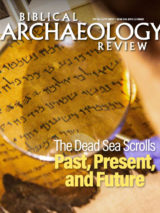What You Missed
Looking back on Spring Fest 2025
It seems like only yesterday that many were waiting on a groundhog to give his forecast for the coming weeks, but now spring is in full swing, Easter and Passover are already behind us, and we’re now all looking forward to summer. With time getting away from us, it’s easy to miss out on interesting events, such as BAS’s Spring Bible & Archaeology Fest that occurred just a few short weeks ago. We were delighted to have a wonderful lineup of scholars give intriguing online lectures and present their research over the course of the weekend. Ranging across the spectrum of archaeology and biblical studies, these lectures left us with exciting new perspectives and much to consider.
For those who missed out on this wonderful weekend, here are a few highlights to whet your palate for future BAS lectures and events.

Spring 2025 Bible & Archaeology Fest speakers Yonatan Adler (top left), Susan Hylan (top right), Rachel Hallote (bottom left), and Jonathan Klawans (bottom right)
The Origins of Judaism: When Did Jews Begin to Keep the Torah?
Yonatan Adler
Our plenary speaker, Yonatan Adler, spoke on his research concerning the origins of Judaism as it pertains to the historical evidence. For many decades, it has been assumed that Judaism as we know it, with its strict adherence to the Torah’s purity laws, gathering for teaching in synagogues, etc., came about after the people of Judah returned from the Babylonian Exile. It was also believed that Ezra was instrumental in establishing this new era of religious piety among the people.
Working backwards from the first century CE—an era where ample evidence exists for adherence to the Torah—Adler showed that the previous view may be incorrect. By investigating various types of evidence, including ritual baths, chalk vessels, and teffelin—hallmarks of early Jewish religious piety—we can see when Judaism began to form. One of the most intriguing pieces of evidence comes in the form of coins minted by local authorities. It is well known that the Jewish people of the first century did not want graven images of people or animals on their coinage. Ample evidence of this fact can be seen, including on coins minted by rulers not known for their religious piety, such as the Herodians or the Roman governors. Even if the prohibition against graven images didn’t much matter to those rulers personally, they recognized that to produce such coins would have triggered outrage among the populace. This practice of religiously sensitive coinage can be seen as far back as the Hasmonean period, after the heroes of the Maccabean Revolt set up the first independent state in Judah since the Babylonian destruction of Jerusalem in 586 BCE. Before this, as far back as the early Hellenistic period, Jewish governors that included high priests were minting coins with pagan images, such as the owl of Athena and the goddess’s famous aegis shield. Like the coins, the other hallmarks of Jewish religious piety also do not appear in the historical record before the Hasmonean period. Looking at the ample evidence, Adler concluded that Judaism appears to have formed under the Hasmonean rulers of the second century BCE.
Become a BAS All-Access Member Now!
Read Biblical Archaeology Review online, explore 50 years of BAR, watch videos, attend talks, and more

Women in the World of the New Testament
Susan Hylen
Professor of New Testament at Emory University’s Candler School of Theology, Susan Hylen offered a fascinating look into the lives and status of women in the greater Roman world—the world of the New Testament. Women of various cultures across the world and in different time periods have often been marginalized and treated as nothing more than the property of their fathers or husbands. We see it in the historical record and in the modern day, which often fuels our assumptions about the past. Using several examples, Hylen showed that this was not the case for women in the Roman period. In fact, many women were independently wealthy and even helped finance some of the period’s most famous monuments. Many were also pillars of their community, with more social prestige than their husbands. Less elite women were also able to own their own businesses and engage in the economic life of the community or in long-distance trade.
One example is Junia Theodora who lived in the city of Corinth in the first century. Several inscriptions discovered in the city were set up to honor her for standing up for various marginalized peoples and mediating their cases before the city’s Roman officials. A Roman woman named Turia, who lived during the rise of Caesar Augustus (first century BCE), was honored by her husband at her death with a lengthy funerary inscription that recounts her virtues and deeds, which included avenging the deaths of her parents and helping family members with financial troubles. Her husband was on the wrong side of the aftermath of the Roman civil war and became a political refugee. Despite having a pardon from Augustus, Marcus Lepidus refused to drop the charges until Turia stepped up and pleaded her husband’s case, enduring verbal and physical abuse in the process.
Women in the New Testament appear to have had the same legal and social status as their peers across the Roman world—they had their own wealth, autonomy, and were local patrons. The Gospels even tell us that Jesus’s ministry was funded by a group of notable wealthy women who were his disciples and patrons, including Mary Magdalene.
Our website, blog and email newsletter are a crucial part of Biblical Archaeology Society's nonprofit educational mission
This costs substantial money and resources, but we don't charge a cent to you to cover any of those expenses.
If you'd like to help make it possible for us to continue Bible History Daily, BiblicalArchaeology.org, and our email newsletter please donate. Even $5 helps:

Between Genuine and Fake: Grading Suspicious Objects on an Authenticity Scale
Jonathan Klawans
Professor of Religion and Jewish Studies at Boston University, Jonathan Klawans delivered a thought-provoking lecture concerning how we should treat unprovenanced artifacts, which are often looted and sold on the antiquities market. Without treading to deep into the muck and mire of the ethical struggles surrounding the publication and study of these artifacts, Klawans addressed how we should treat these items of dubious historical value. Scholars have often taken a binary approach when it comes to unprovenanced artifacts. Since the archaeological context of such items can never be known for certain, they are treated by some as forgeries with no historical value. Other scholars take their authenticity at face value and consider them to be historical artifacts.
In contrast, Klawans proposed using a grading scale between 1 and 5, with 1 being “very likely forged” and 5 being “very likely authentic.” He then demonstrated this scale using several controversial items that have graced the pages of Biblical Archaeology Review over the decades. Category 5 items are often ubiquitous and can be compared to many standard items recovered from archaeological excavations, such as ceramics and coins. Falling into Category 1 is the infamous Ivory Pomegranate with the words “belonging to the temple of God.” Once displayed in the Israel Museum as a relic of the First Temple period, the artifact is now considered a forgery by most in the scholarly community. While not completely proven a fake, the pomegranate has raised many red flags concerning its authenticity, including its uniqueness and the fact that the ivory itself has been dated to the Bronze Age. Fairing only slightly better as a Category 2 object is the infamous James Ossuary. The bone box itself is often considered authentic, along with the “James the son of Joseph” part of the inscription; however, the inscription’s “brother of Jesus” element remains in question. Given the fact that the ossuary came from a collection that included other known forgeries, its authenticity should be considered highly questionable.
This year’s Spring Bible & Archaeology Fest included many more wonderful lectures by brilliant scholars. If you didn’t get to attend, fear not, there are upcoming opportunities, both online and in person. (And so many fascinating topics!) BAS will run the public symposium “The Life of Jesus in History and Archaeology” this May and a summer seminar, “Fakes, Mistakes, and Media Misrepresentations in Biblical Archaeology,” in July. Be sure to plan for our 28th Annual Bible & Archaeology Fest in Boston, Massachusetts (and online), where we will be celebrating the 50th anniversary of Biblical Archaeology Review.
Must-Read Free eBooks
Want more Bible history?
Sign up to receive our email newsletter and never miss an update.
Unlock Unlimited Access to the Bible's Past
Become an All-Access Member to explore the Bible's rich history. Get Biblical Archaeology Review in print, full online access, and FREE online talks. Plus, enjoy special Travel/Study discounts. Don't miss out—begin your journey today!












